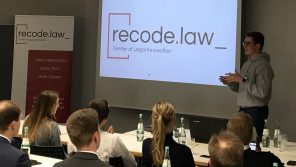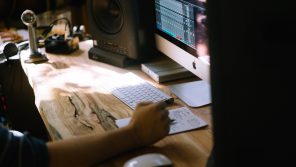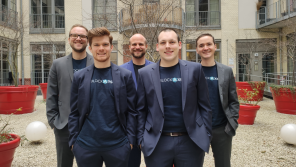CAL2 is at the forefront of legal tech research in Germany. CAL2 is short for Computer Assisted Legal Linguistics. Members of CAL2 are linguists, lawyers and computational (corpus) linguists who explore the fabric of language and law in Europe and the world. Since 2014 CAL2 has developed new big and multilingual reference corpora of legal texts (cf. JuReko) and tested computer supported methods as a basis for new perspectives on both micro and macro structures of legal meanings and dogmatics.
Corinna Coupette conducted an interview with Dr. Dr. Hanjo Hamann. Dr. Hamann is a Senior Research Fellow at the Max-Planck-Institute for Research on Collective Goods in Bonn (Germany). With a research focus in private and corporate law, he connects legal studies with empirical methods and big data linguistics. He is a Junior Fellow of the Baden-Wurttemberg Academy of Sciences, jointly with legal linguist Prof. Friedemann Vogel, both of whom founded the CAL² research group.
Corinna Coupette: Dr. Hamann, there is currently a lot of buzz about legal tech for legal practice. At CAL2, you are using technology to advance legal research. What is your objective?
Dr. Hamann: Our research group assesses the use of computational linguistics to help us understand and improve the law. Our tenet is simple – simple enough for Forrest Gump (had he been a philosopher of law) to state: “Law is as lawyers do.” So what do lawyers do? They speak and write authoritatively, trying to convince each other and to reach consensus on normative issues. Put differently: They constantly produce texts and relate them to each other – they weave a fabric of texts. Media theorists call this fabric “hypertext”, like the Internet. So what we want to find out is: Who “rules” this hypertext and how? Where do meaning and normativity come from? There’s no central authority, so no single text can tell you. But we look at the bigger picture. We take texts in bulk (so-called corpora) and analyze their interrelations, their structure and recurring patterns. This is how we get a bird’s-eye view of the network of legal texts, as if we were mapping parts of the Internet. This perspective lets us watch, reconstruct and predict legal developments as they ripple through the fabric of legal language.
What does that mean specifically? What exactly do you do?
We proceed in several steps. First we have to make this hypertext visible. Imagine you tried to analyze the network of human communications before the Internet: You would have had to collect millions of written or printed letters, telegrams and communiqués, then you would have had to preprocess them for digital analysis. That’s what we currently do: We collect millions of legal texts from all domains (judiciary, lawyering, legislature, legal academy, etc.) and construct a “reference corpus” that can be used for research. This is the first such attempt world-wide and a labor-intensive task, so we had to secure substantial funding from the Heidelberg Academy of Sciences. In the second stage of our project, we will try our approach on specific questions, as we have done earlier on smaller scale, along with associates of our group in the US and the UK, in Spain and Italy. We will gather those international partners, along with the world’s best and most visible scholars in this field, for an international conference that will take place in Heidelberg in March 2016. This conference will determine our way forward, so anyone interested is welcome to join us for lively discussions.
CAL2 is a fundamentally interdisciplinary effort – and so is Legal Tech. From your experience at CAL2, what are the cornerstones of successful collaboration between lawyers and experts from other (more technology-driven) fields?
Indeed we, too, are a mixed lot. Our core team consists of a legal linguist, a lawyer/economist and two computational linguists. So we have to communicate effectively across the boundaries of social sciences, humanities and computer science. This challenges us but it also helps us to keep any particular perspective from taking over. Some decades ago, when computer enthusiasts invented “legal cybernetics”, they often sought to use technology to supplant normative reasoning, conceiving of law as merely a code that programs human behavior. You sometimes see similar attempts in today’s legal informatics. But our collaboration discourages this view: We are convinced that any analysis of law must be fundamentally hermeneutical in nature, so our group explicitly relies on computers merely for “assistance”. This is sometimes difficult to communicate to IT experts, whose methods seem to allow for much more. But if you look more closely, legal discourse is an all too complex and inherently social phenomenon. As much as we need quantitative support and descriptive data, our purpose is to provide normative conclusions through qualitative reasoning. This purpose has to be checked against mechanistic over-simplification, which might be tempting in light of the “power” of computing.
Apart from your work at CAL2 – what opportunities do you see for Legal Tech in Legal Research?
I have no doubt that technology will fundamentally change the way we do legal research. We started with simply data-basing information retrieval, through legal databases and web-portals (though a lot remains to be done in Germany.) We see a push for evidence-based jurisprudence by, for example, using statistically advanced meta-analyses, as I argued in my first PhD thesis. We may soon see a surge in legal decision support systems, similar to those medical doctors have been using for a while. We might replace law as a regulatory instrument in technical and routine matters by smart contracts, backed by block-chain infrastructure. If those speculations come true, such technologies will find their way into legal research as both study subjects and methods of study. Opportunities can, of course, only arise where lawyers equip themselves to face them. Knowing the basics of data science and programming will become more relevant for serious legal researchers.
Traditionally, legal research has been quite remote from legal practice. What you do at CAL2, however, sounds related to the data analyses some Legal Tech Startups build their business cases on. Could Legal Tech help build bridges between legal academia and the legal industry?
I tend to disagree that legal research and legal practice have traditionally been detached. This may be true for contemporary US legal research (and a lot of US scholars have sought explanations and remedies for that) but is not equally as true for continental European jurisdictions. This disagreement aside, our project does seek to bridge academia and industry by explaining actual legal decision-making from a theoretically-informed and empirically-sound perspective. For instance, one associate of our group analyses how social security judgments shape and alter our perception of people in need of social security support (German “Hartz IV”). This analysis will surely be useful for lawyers, social workers and legislators alike. I should note, however, that our project seeks to contribute to basic research, so the legal industry will not find ready-made solutions. What they should turn to our research for instead are scientifically sound insights that inspire new solutions.
Thank you!




